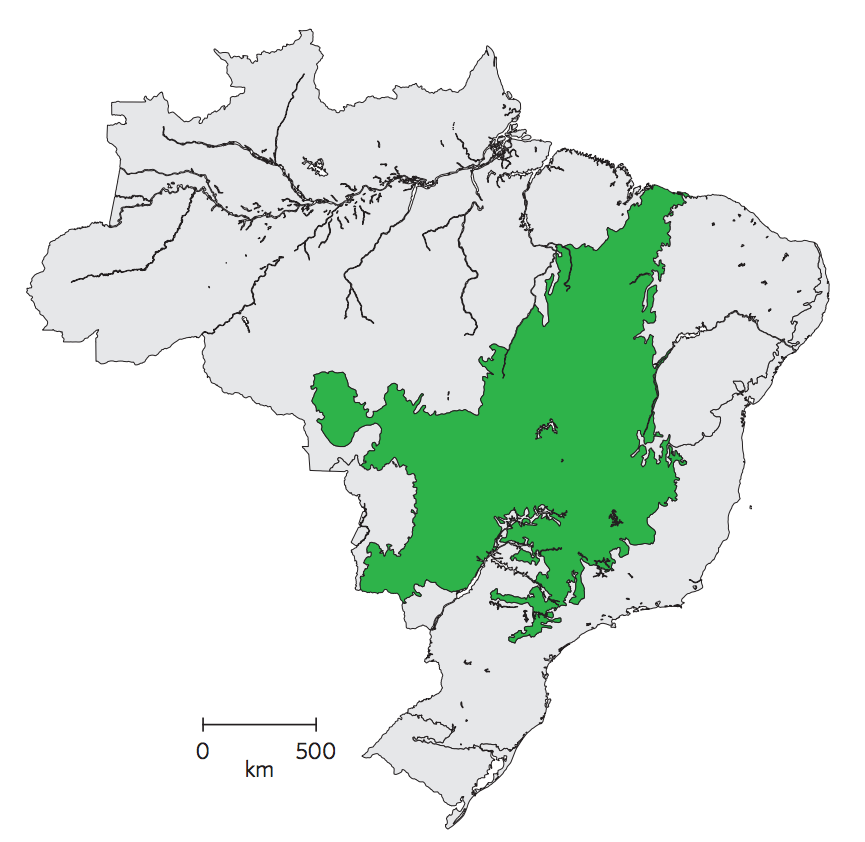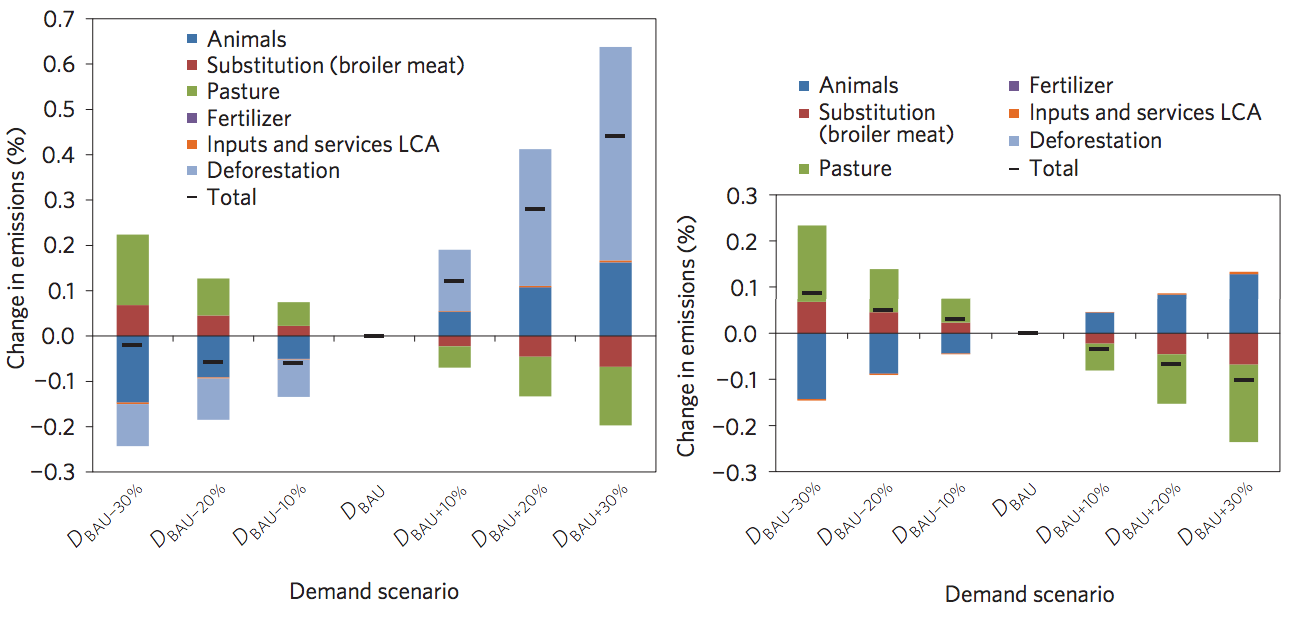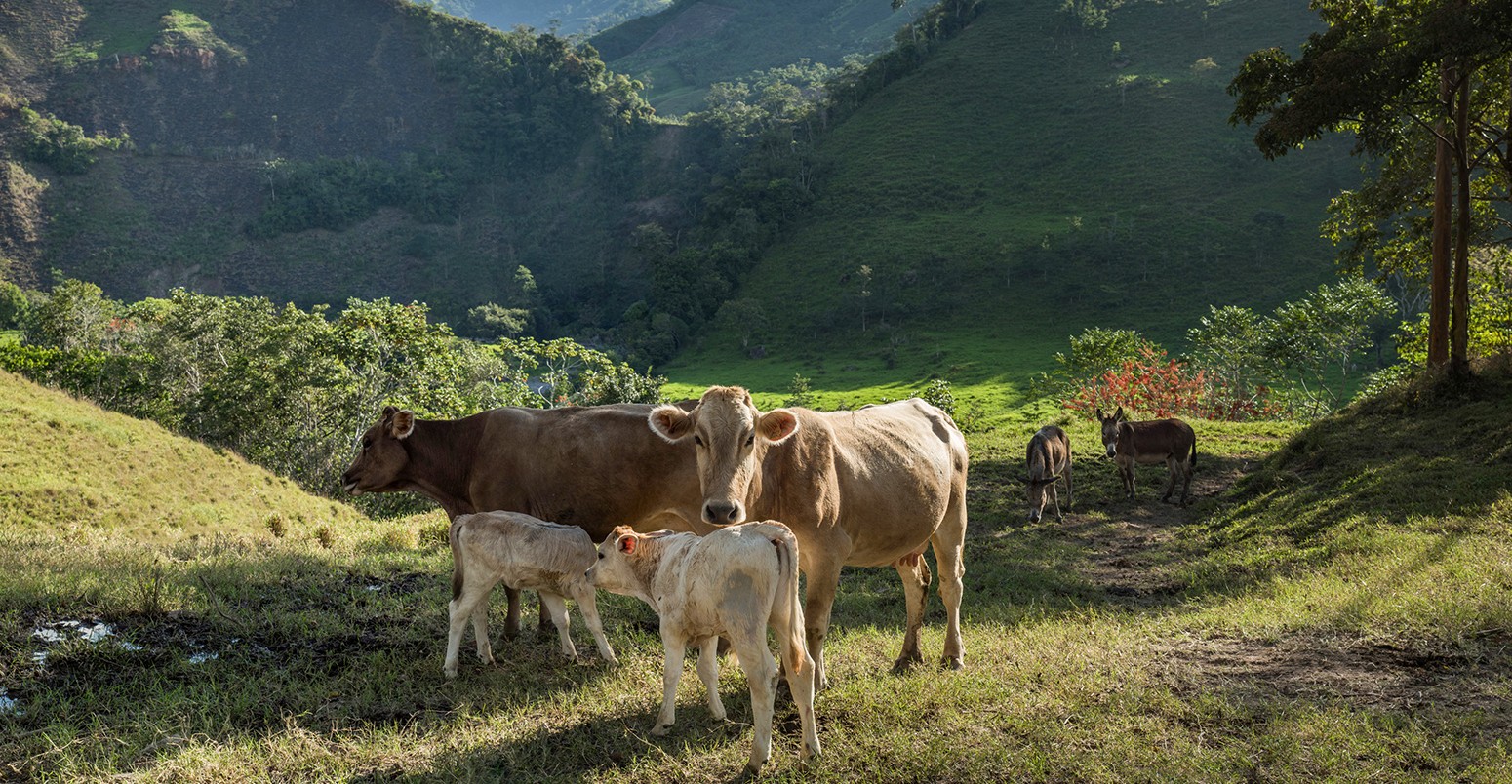Higher beef production could lower Brazil’s emissions, study says
Robert McSweeney
01.18.16Robert McSweeney
18.01.2016 | 4:00pmIncreasing beef production in Brazil could actually lower its national emissions by maximising the carbon stored by pasture, a new study says. But the benefit only holds as long as more forests aren’t cleared for rearing cattle.
This counterintuitive finding differs from recent studies that have argued reining in rising demand for meat and dairy products is fundamental to reducing global greenhouse gas emissions.
What does this mean for climate-conscious diets? Should we be eating more meat to limit climate change? Carbon Brief chews over the research.
Deforestation
Beef is by far the least climate friendly meat to eat. Producing a kilogram of beef emits an average of 290kg of CO2e. Greenhouse gas emissions come from converting and fertilising land for grazing, feed, transporting animals, and from the gases and manure produced by the cows themselves.
Brazil is home to more than 200m cows and is second only to India in terms of how much beef it exports each year.
Historically, the beef industry has been one of the principal drivers behind Brazil’s deforestation. Since the 1960s, approximately 15% of the Amazon rainforest in Brazil has been cleared for farming and around 80% of that cleared land is now used as pasture for livestock.
But there is evidence that the link between deforestation and beef production has been broken, say the authors of the new study in Nature Climate Change. Rafael de Oliveira Silva, a PhD student from the University of Edinburgh and Scotland’s Rural College (SRUC), and Prof Dominic Moran, an economist at SRUC, tell Carbon Brief:
After peaking in 2005, deforestation rates have been on a downward trend in all Brazilian biomes [habitats], while beef production has simultaneously been increasing.
If deforestation is no longer a factor, this leaves more scope for the beef industry to reduce its emissions, the researchers say, and these savings could be further propelled by increases in demand.
Grass is greener with higher demand
The study focuses on the Cerrado region that runs through the centre of Brazil (see map below). Around a third of Brazil’s beef is produced there.

Map of Brazil’s Cerrado region (shaded green). Source: de Oliveira Silva et al. (2016).
Approximately 90% of beef cows in Brazil are fed on grass. Most pastures are planted with tropical grasses of the genus Brachiaria, which are very effective at absorbing CO2 from the atmosphere and storing it as organic carbon in its roots. Studies have shown that, when well managed, these grasslands can be used to sequester carbon in the soil.
Higher demand for beef pushes farmers to get the most out of the grass on their pasture and boosts how much carbon it stores, the papers says, while low demand has the opposite effect:
Lower demand and smaller herds require less grass production, reducing the incentive to maintain or increase productivity; pastures then degrade, losing organic matter and soil carbon stocks.
The researchers tested this effect by simulating the impact on carbon emissions of a “business-as-usual” scenario of beef demand in 2030 and six scenarios of higher (+10%, +20% and +30%) and lower (-10%, -10% and -30%) than business-as-usual demand in 2030.
You can see the results in the charts below, which show the difference in emissions between each scenario and business as usual. If forests are cleared to provide pasture (light blue bars), then overall emissions from higher beef demand are much larger than for business as usual and lower demand (left-hand chart). However, without deforestation, the improvements to pasture (green bars) would mean higher demand brings lower total emissions (right-hand chart).
As the researchers explain:
Basically, if deforestation is held constant by effective policy, then any reduction in consumption or demand will likely lead to a reduced incentive to manage or improve carbon-rich grasslands. Emissions could actually go up as a result.

Modelled percentage differences in accumulated carbon emissions between 2006 and 2030 from different beef demand scenarios, with deforestation (left-hand chart) and without (right-hand). Where DBAU is business-as-usual beef demand in 2030, and DBAU-10%, etc are lower demand scenarios, and DBAU+10%, etc are for higher demand. Bars above the origin line indicate increases in emissions, while bars below show emissions savings. Thick black lines show overall emissions for that scenario. Source: de Oliveira Silva et al. (2016).
Looking longer-term, eventually there would be a limit to how much extra carbon the grasses could take up and store, the researchers say, but this wouldn’t be reached for about half a century.
Important assumptions
So, how much difference could higher beef demand make to Brazil’s overall emissions? Quite a lot, say de Oliveira Silva and Moran:
That is a tricky question, but a rough estimate is between 10-20% of Brazil’s total national annual emissions.
As Brazil is the world’s twelfth largest emitter of CO2, that’s a sizeable chunk of emissions.
The results of the study have already fed into Brazil’s intended nationally determined contribution (INDC), the researchers say. INDCs are the pledges that countries submit to the UN, setting out how far they intend to reduce their greenhouse gas emissions.
Brazil’s INDC says it aims to restore an additional 15m hectares of degraded pasture by 2030, and enhance 5m hectares where land use is rotated between crops, livestock and forests – also by 2030.
It’s worth noting that the new study’s findings are based on a couple of important assumptions, says Rob Bailey, research director at thinktank Chatham House. Bailey wasn’t involved in the study, but has co-authored recent studies at Chatham House on demand for meat and dairy products. The first assumption is that cattle ranchers will increase the productivity of their pasture when they can’t expand into forests, and the second is that the additional carbon storage by the grasses will be as significant as expected.
That aside, the study shows how important the methods of meat production are, says Bailey:
Chopping down trees is bad. Restoring pasture and soil carbon is good. If you avoid the latter and do the former, your emissions intensity will improve and it’s plausible that in the right circumstances you can get more beef for fewer emissions, which is what the authors find in this example.
But that doesn’t necessarily mean that we should be firing up our barbecues, Bailey adds:
From the point of view of reducing emissions, however, the best thing to do is to not chop down trees and restore degraded pasture, but have no cows on it at all.
Main image: Cows in Pozuzo, city of the amazon rain forest. © Christian Vinces/Shutterstock.
de Oliveira Silva, R. et al. (2016) Increasing beef production could lower greenhouse gas emissions in Brazil if decoupled from deforestation, Nature Climate Change, doi:10.1038/nclimate2916.


